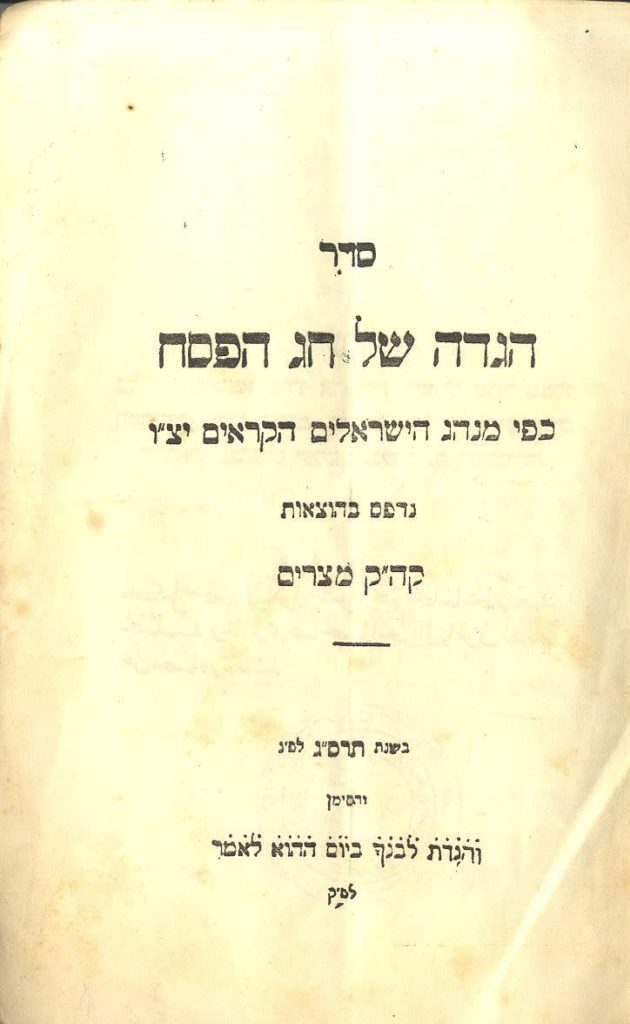
Seder Haggadah Kefi Minhag HaYisraelim HaKara’imֲ printed by the community in Egypt.
Facsimile print of the haggadah printed in Budapest in 1903 (See Otzar HaHaggadot 1618). Jacket cover per earlier publications.
There is a comment on the back of the title page – a warning from the Karaite Beit Din in Egypt that each copy of the haggadah must contain the stamp of the Karaite sect. The copy before us contains such a stamp.
Rare haggadah! Not listed by Ya’ari, and does not appear inֲ Otzar HaHaggadot. The bibliography of the Hebrew book no. 000201245 lists a haggadah like this one, but with the name of a printer (see supplements by Ben-Menachem to 18).
17 pages, 20 cm; very fine condition. Jacket cover.
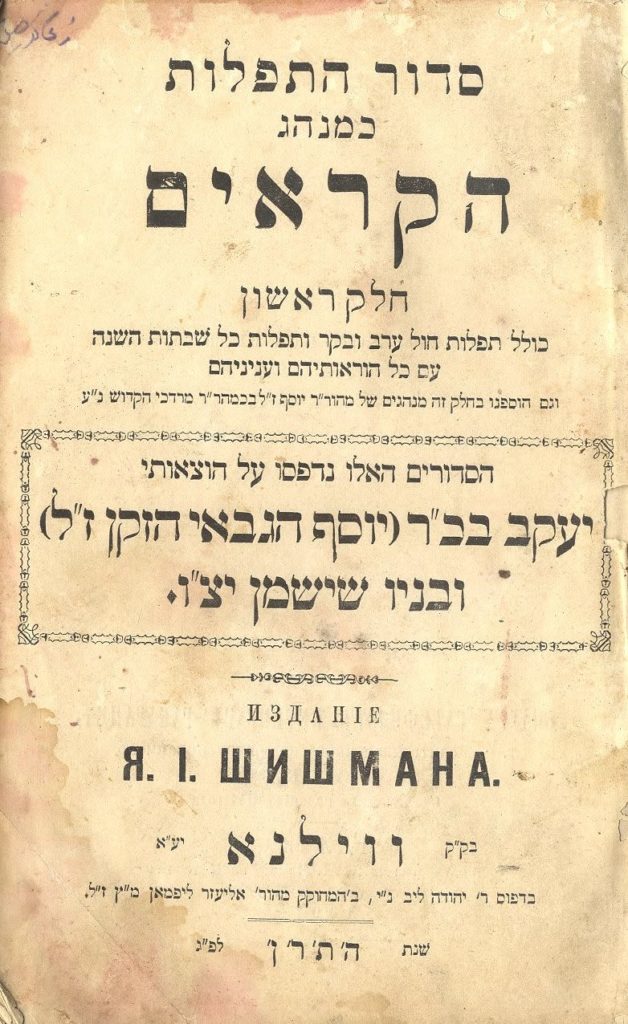
* Siddur HaTefillah K’Minhag HaKara’im, Part I. Vilna, 1890. Weekday prayers … Shabbats … and with a supplement of Karaite customs by Rabbi Yosef z”l son of Rabbi Mordechai HaKadosh. [2], 464 pages, 22 cm.
* Siddur HaTefillah K’Minhag HaKara’im, Part II. Festival prayers. Printed by Yeshuah Shmuel and Sons. Al-Qahirah [Cairo], 1935. 312, [1] pages. The Bibliography of the Hebrew Book records that they saw only this second part, and the collection at the National Library only contains this second part; apparently more parts were not printed during that same period.
*ֲ Siddur HaTefillah K’Minhag HaKara’im im kol Hora’otehah V’Inyanehem, Part I. Published by Chevrat Bachurei Ahavat Torah L’Yisrael HaKara’im B’Mitzrayim. Cairo, 1946. Weekday prayers, evening and morning, and prayers for all the annual Shabbats. 464 pages, 24 cm.
*ֲ Seder Tefillot HaKara’im, work of Shlomo … ben Rabbi Yitzchak HeChacham … and Moshe … Tungur, by Rabbi Yitzchak … son of Rabbi Shlomo Iskowitz, Part IV. Vienna, 1854. [2], 222 pages, 24 cm. Possibly lacking the last leaf.
*ֲ Sod HaTefillah, Parts I & II. Printed by Kh”k HaYisraelim HaKara’im Ytz”u B’Mitzrayim, with the approbation of the Va’ad and the Beit Din. Budapest, 1903. Part I: Weekday evenings and mornings, Rosh Chodesh, Purim and the four fasts. 112, [3] pages. Part II: Shabbat Evenings and mornings, and Rosh Chodesh. 172 pages. 19 cm. (Blemish on the last leaf.)
Overall fine condition.
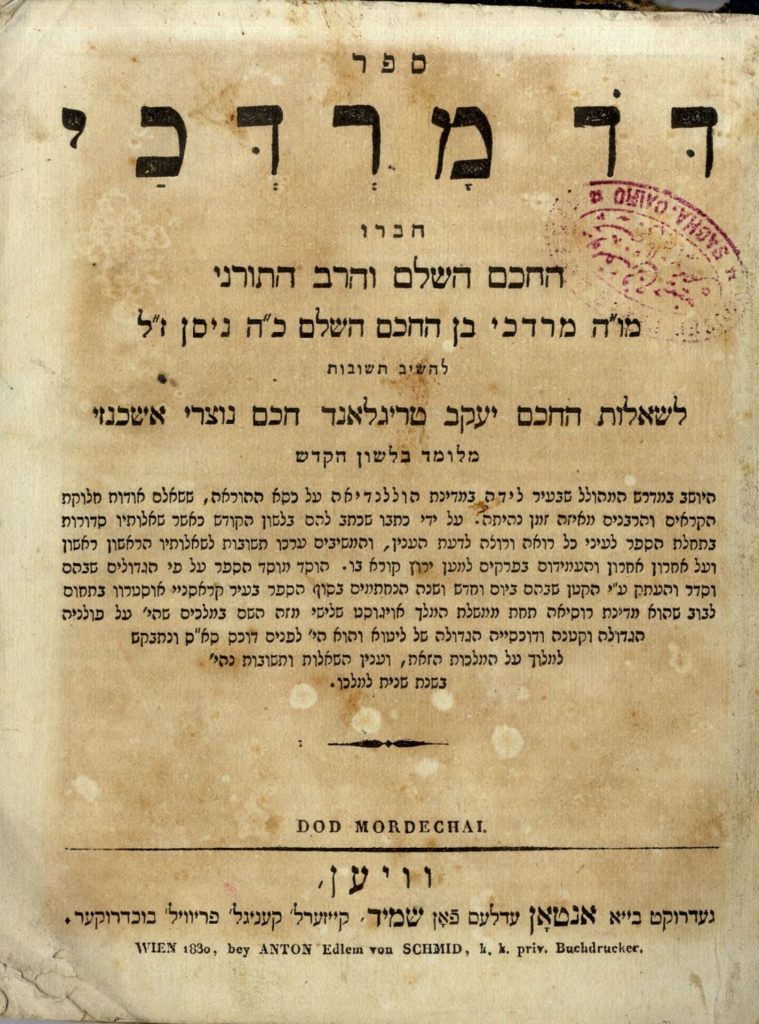
*ֲ Dod Mordechai – the essence of Karaite faith, Karaite books, and Karaite laws of ritual slaughter, by Mordechai ben Nissan. Vienna, 1830. [4], 36, [1] leaf, 22 cm. This book includes Karaite responsa to the Christian scholar Jacob Trigland about the essence of the Karaites. Leaf of errata at the end. Printed together with the books: Orach Tzaddikimֲ about the dispute between the Karaites and the rabbis, with a list of Karaite books, separate half title page;ֲ Kitzur Inyanei HaShechitah by Eliyahu Bashitzi to Karaite,ֲ separate half title page.
*ֲ Pinat Yikrat, the ten fundamental principles of Karaite faith, with a list of mitzvahs, missives and letters about Karaite faith. Gozlov, 1934. Handwritten (in pencil) notations, comments and corrections along the entire length of the book. This is an important composition on the foundations of Karaite faith by Yitzchak ben Shlomo the Karaite. The book was edited by Avraham Perkowitz, who also added his own content. Introduction in Kadar [the language of the Karaites]. There are several variants of this book, and there were additional leaves added to it printed in 1840. Refer to the Bibliography of the Hebrew Book listing number 000135787. The copy of this book before us is without the leaves which were added later. Pagination according to this copy: [2], 15, [1]; [18] leaves, 20 cm. Some of the leaves were printed on blue paper.
* ‘Inyan HaShechitah’ manuscript. Vowelized manuscript. Lined notebook, 23 pages written in block vowelized script. Apparently, the booklet Inyan HaShechitah L’Adat HaYehudim HaKaraim (Ramleh? 1958), which appears below, was printed from this manuscript.
*ֲ Inyan HaShechitah L’Adat HaYehudim HaKaraim, by Chacham Shmuel HaKohen [Ramleh?] 1958. 16 pages. Jacket cover. Vowelized.
*ֲ Seder Haggadah shel Chag HaPesach k’fi Minhag HaYehudim HaKaraimֲ published by Chevrat HaHatzalah L’Vnei Mikra B’Medinat Yisrael. Jerusalem, 1961. 24 leaves.
* Single leaf in Karaite-Arabic.
Overall fine condition.
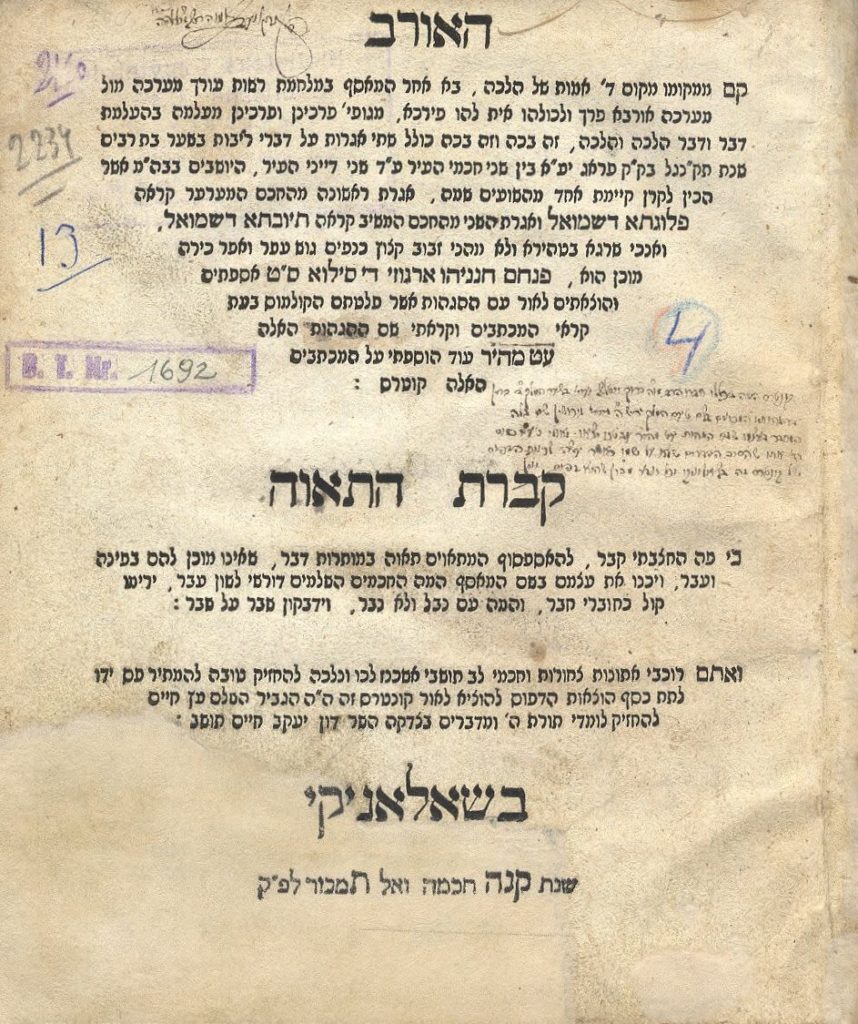
HaOrevֲ – controversy about the Prague rabbinate after the passing of the gaon Rabbi Yechezkel Landau, author ofֲ Noda BiYehudah. Salonika, [Vienna?] 1795. Only edition. Rare book. After Rabbi Yechezkel Landau’s passing after almost 40 years as rabbi of Prague, a dispute erupted about the leadership of Prague between the Noda BiYehuda’s son, Rabbi Shmuel, who had already begun to serve as dayan and assistant to his aging father, and two dayanim in Prague, Rabbi Michael Bachrach and Rabbi Ya’akov Ginzberg, who acted independently. The book before us, which was published anonymously, cites letters and claims from both sides. The letters are called “Plugta D’Shmuel” and “Tiyuvta D’Shmuel.” The author used the pen name “Pinchas Chananyah Argozi.” There are a number of hypotheses with regard to the author’s identity. There are those who wrote that he was Rabbi Shaul Hirschel Levin (Berlin). However, the author was apparently actually Rabbi Baruch Yaltash of Prague, author of Taam HaMelech on the Ramba”m’s “Sha’ar HaMelech,” which hints at his being the author. Also, the place of print indicated on the title page – Salonika – is incorrect, and the book was apparently printed in Vienna. The compilation “Kivrot HaTa’avah” is printed on the last three leaves – a public notification by Rabbi Shmuel Landau that he does not want to be published in the book HaMeasef. There is an interesting halachic deliberationֲ on the first leavesֲ about early Jewish coins – whether they had impressions of people on them, including the expert opinion of a gentile who wrote his view in French. Rabbinic signatures and owner’s notations from the time of printing, including an interesting notation on the title page about the question of the author’s identity. 20 leaves, 19 cm. Fine condition. Professional restoration to the title page with a small photocopied completion. Aging stains and isolated worming perforations. Cropped upper margins. Detached back binding.
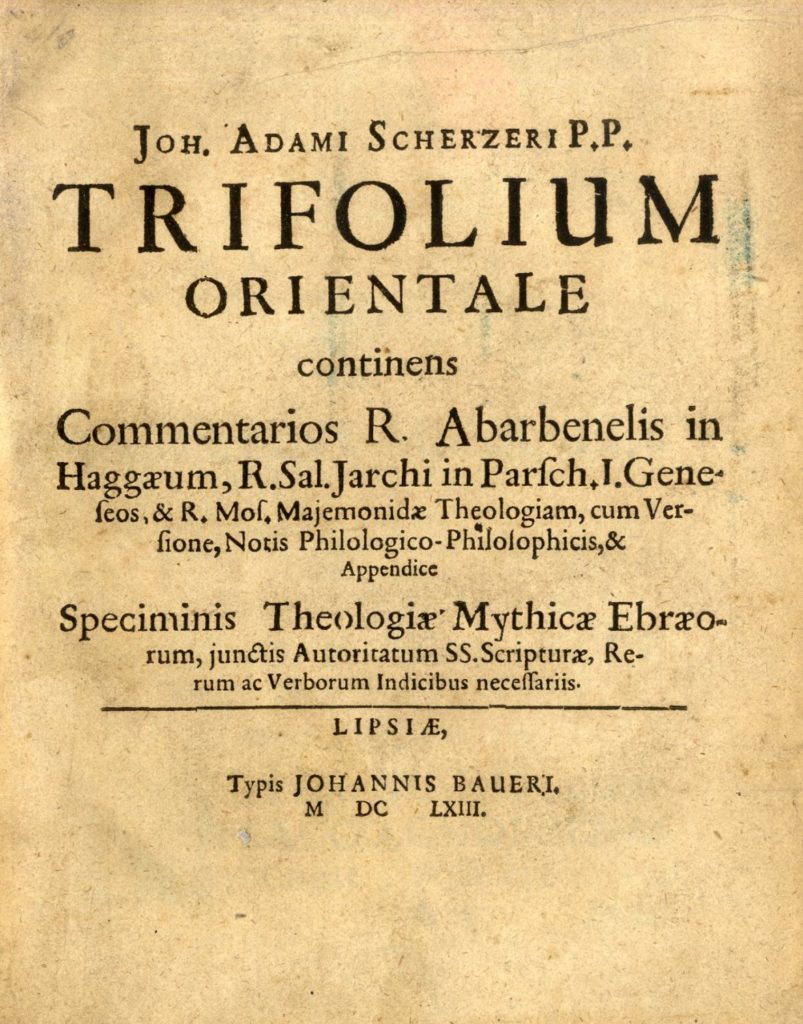
Joh. Adami Scherzeri P.P. Trifolium Orientale continens Commentarios R. Abarbenelis in Haggֳ¦um, R. Sal. Jarchi in Parsch. I. Geneseos, & R. Mos. Majemonidֳ¦ Theologiam, cum Versione, Notis Philologico-Philolophicis, & Appendice Speciminis Theologiֳ¦ Mythicֳ¦ Ebrֳ¦orum, junctis Autoritatum SS. Scripturֳ¦, Rerum ac Verborum Indicibus necessariis
The author, Johann Adam Schertzer, was a German theologian and a Lutheran cleric, teacher of the famed scientist and philosopher Gottfried Leibniz.
[8] 170 [14] pp, 19 cm. Fine-very fine condition, dismantled binding.
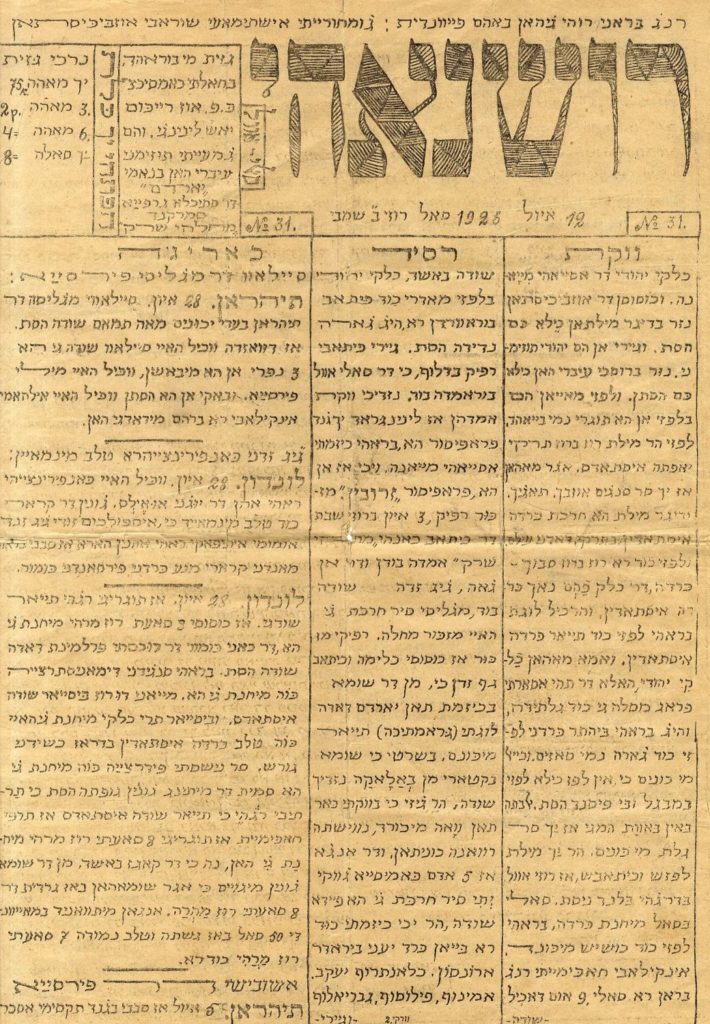
Issue number 31 of the rare journalֲ Roshanahi – Bukharian-Nationalist-Jewish journal. Printed by lithograph on a large sheet. Bukharian in Hebrew letters. This issue also includes news from Teheran, London and Moscow.
Towards the end of 1925, a Judeo-Bukharian newspaper called Roshanahi [“My Light”] began to appear. It published the literary works of the first Bukharian creators of the Soviet era, including M. Ch. Bachiev [Mochiv], Gabriel Samandrov, Yehonatan Khurayev, Ya’akov Chaimov and others. Roshanahi served as the official bulletin of the Central Bureau of Bukharian Jews, to the side of the propaganda wing of the Cheka (the secret political police of the Communist regime after the revolution).
Before us is an extraordinarily rare journal. The National Library collection contains only some of the published issues, and of the issues published in 1926, they only have photocopies. According to some historians, the issues of this journal published that year were printed in only 200 copies. (Regarding this journal, see more in Handbook of Jewish Languages Boston-Leiden, 2016, pp. 263-264; and Pa’amim, a multidisciplinary quarterly on research of Jewish communities in the East, published by Machon Ben-Tzvi, issue 136.)
4 pages, 45×35 cm. Moderate-fine condition. Fold marks. Tears without lack, mainly in the folds.
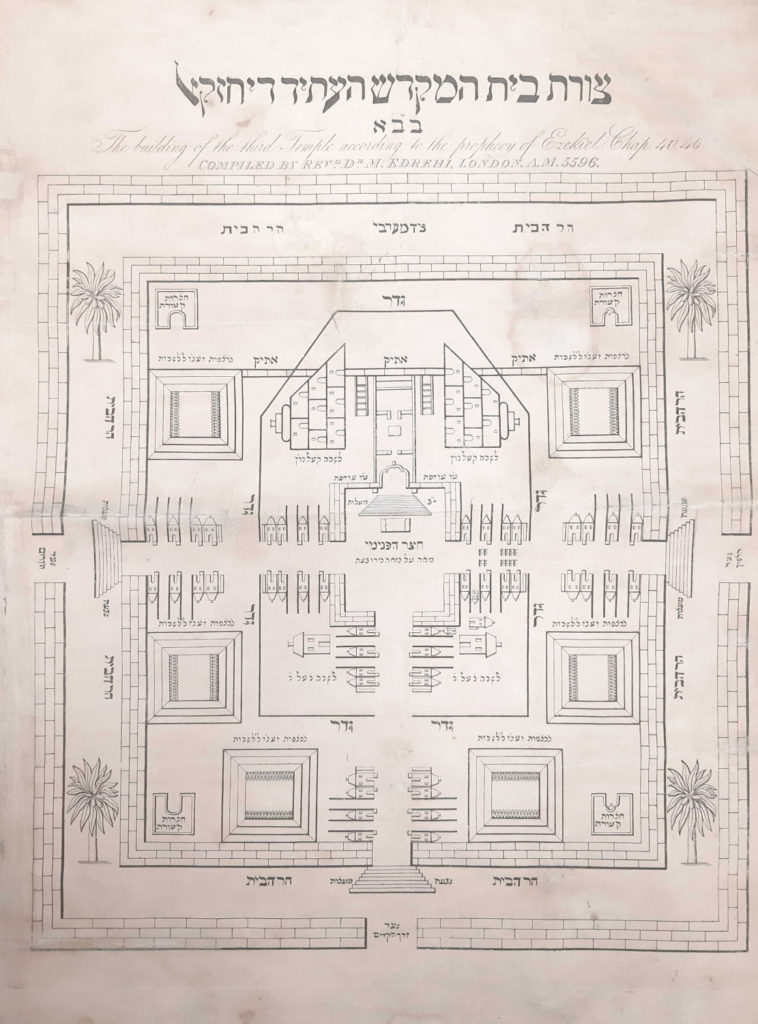
Printed diagram of the Third Temple, to be built in the future, with Hebrew writing, titled in Hebrew and in English.
This wondrous diagram was drawn by the kabbalist Rabbi Moshe Edrei (!).
Rabbi Moshe bar Yitzchak Edre’i [c. 1775-1842] was born in Mogador and studied in Rabat. He was a disciple of Rabbi Yehudah Anhori. He later immigrated to Europe where he lived in several countries. Already in 1792, while he was yet very young, he arranged Torat Chaimֲ (London, 1792), kabbalistic studies for Friday nights. Aside from being a scholar of both the hidden and the revealed [aspects of Torah], he was also a scholar of general knowledge. He lived in Amsterdam, where he learned ancient languages. He printed his bookֲ Yedei Moshe (sermons and eulogies) in Amsterdam in 1729. He moved on from there to England, and towards the end of his life he ascended to Jerusalem. He authored the renowned book Ma’aseh Nissim – She’erit Yisrael about the Sambatyon river and the ten tribes. More material about him is included with this lot.
[1] leaf paper, 33.5×44 cm.
Fine condition. Professionally restored tears.
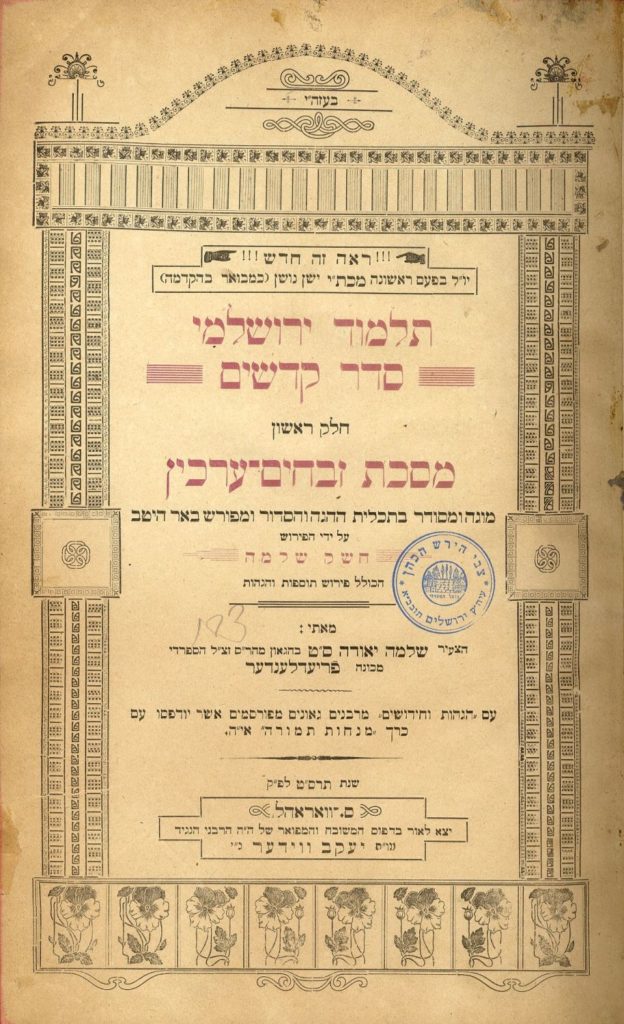
Before us is the famed forgery by Shlomo Yeudah HaSepharadi – Friedlander. There is a photocopy of the manuscript from 1212(!) on the back of the first title page; a proven forgery.
As is known, we only have the Talmud Bavli on Seder Kodshim, which deals with the services in the Beit HaMikdash. The above author relates that he acquired a very ancient manuscript from the Benveniste family of Turkey, in which he discovered the Talmud Yerushalmi on Seder Kadshim. The author managed to receive approbations from important public figures, including rabbis and renowned academics. However, it was later discovered that it was an artful forgery, and all the stories about the manuscript’s discovery were lies and deception. There were two volumes printed in total, including Tractates Zevachim, Erchin, Chulin and Bechorot. With a lengthy introduction to “prove” the book’s veracity.
[8] 100 leaves. Including the table of errata. 33.5 cm. Very fine condition. Somewhat brittle paper.
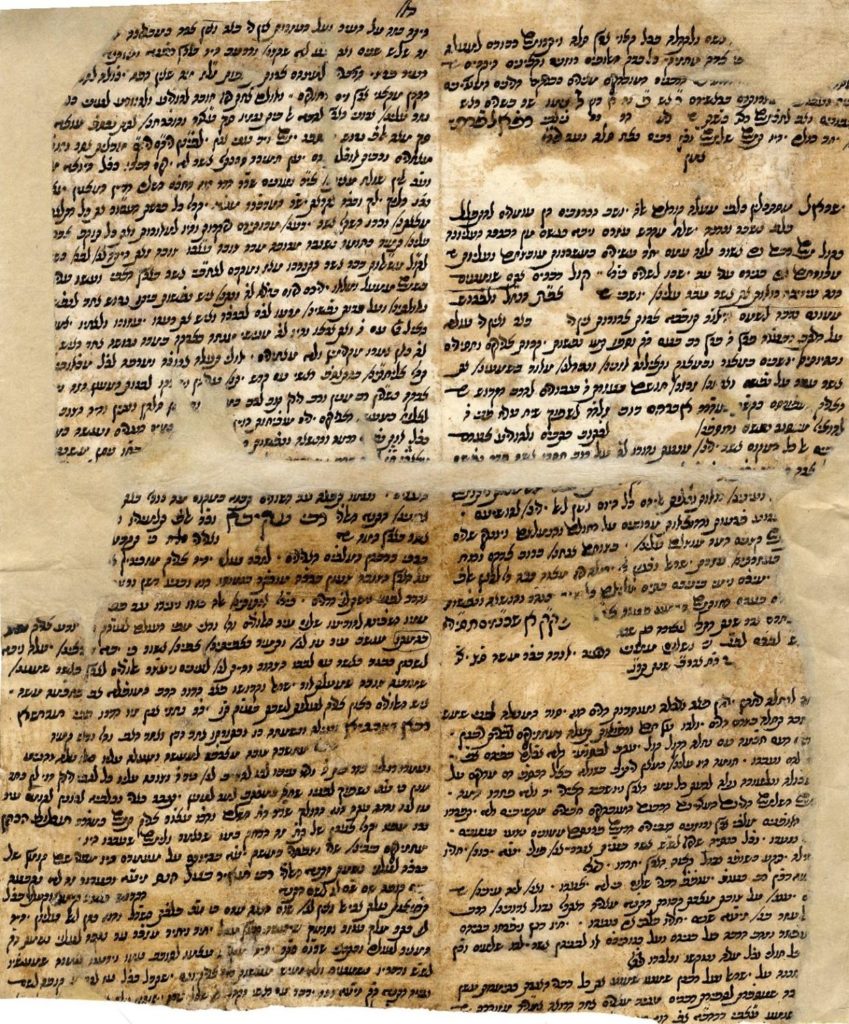
Letter from the heads of the Safed and Tiberias communities to the great minister, Rabbi Rephael Farhi – minister of finance in Damascus, about the earthquake in Safed and Tiberias.
An earthquake struck Safed and Tiberias and desperately hurt the local Jewish communities. It took the Jewish settlement there many years to recover from the ruin of that earthquake and the damage it caused.
Before us is an emotional letter sent to the great minister, Rabbi Rephael Farhi, who was the minister of finance in Damascus, and held enormous influence on the Jews of Syria, with a call to come to the assistance of the Galilee settlers.
The letter mentions the study hall of ‘The famous tzaddik, Rabbi Avraham Dov, zlh”h- Rabbi Avraham Dov of Ovritch, author of Bat Ayin.
Torn letter, incomplete. The beginning of the letter is stamped by Yeudah b”r Moshe S”T, and later on in the letter there is mention of Rabbi Machluf HaKohen’s mission – a mission not mentioned by Ya’ari.
[1] leaf paper. 22×26 cm. Oriental script.
Fine condition. Professionally restored with damage to text. Cropped lower margins.
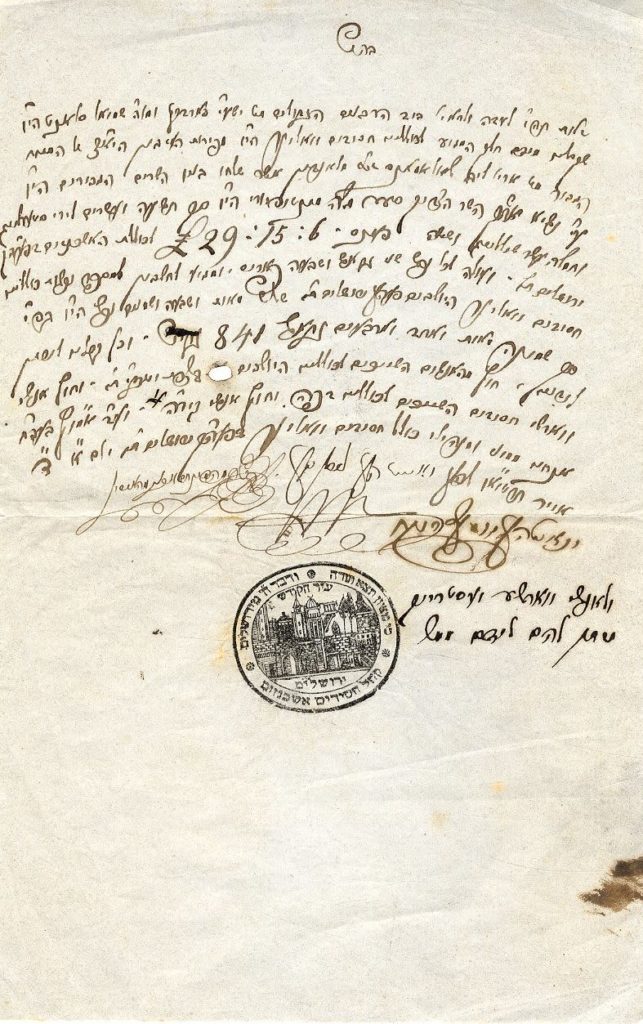
The oldest kollel was “Kollel Chassidim,” which was also called “Kollel Vohlin,” and occasionally also “Kollel Russia.” It started in Tiberias and continued in Safed and then in Jerusalem. All the Chassidim who ascended to the Land with Rabbi Menachem Mendel of Vitebsk joined this kollel at first, without geographic differentiation. However, processes of division by geographic region of origin began, then these association patterns gradually narrowed and the kollels split and increased in number.
Until c. 1860, most Chassidim who were born in the areas of the “Pale of Settlement,” Kiev, Vohlin and Podolia, the regions of New Russia, Serbia and the principalities of the Danube (and Lachia and Moldavia) registered with Kollel Volhin. Kollel Volhin in Safed was already founded in 1796, and the kollel in Jerusalem only in 1841, with the move of the Beck family from Safed and the establishment of the Chassidic community in Jerusalem. Another stage in the split of Kollel Volhin in Jerusalem was around 1955, with the establishment of Kollel Reisin, which dealt with distributing monies to Chassidim of White Russian and Lithuanian descent. The kollel was centered in Tiberias and the quality of the relationship with Kollel Vohlin is not clear.
This document attests to a respectable donation from the estate of philanthropist Aryeh Leib Shaul … Segal? of London for Kollel Chassidim in 1851. The donation was transferred to the leaders of the Perushim kollel: Rabbi Yeshayah Bardaki and Rabbi Shmuel Salant, and they transferred it to the heads of the Volhin kollel. However, they were to transfer part of the donation to other people as well, who were not part of the Perushim society, and had not yet established their own kollels – the people of Poland and ֳ–sterreich. Apparently, Rabbi Shmuel Salant added this request: “Transfer to the people of Warsaw and ֳ–sterreich, to be given directly into their hands.” With a stamp from Kollel Chassidim: “Kehal Chassidim Ashkenazim” – a very rare stamp. Iyar 1851.
This document recalls the friction between the various groups in Jerusalem at the beginning of the founding of the settlement there.
[1] leaf paper. 22×14 cm. Fine condition. Tiny holes.
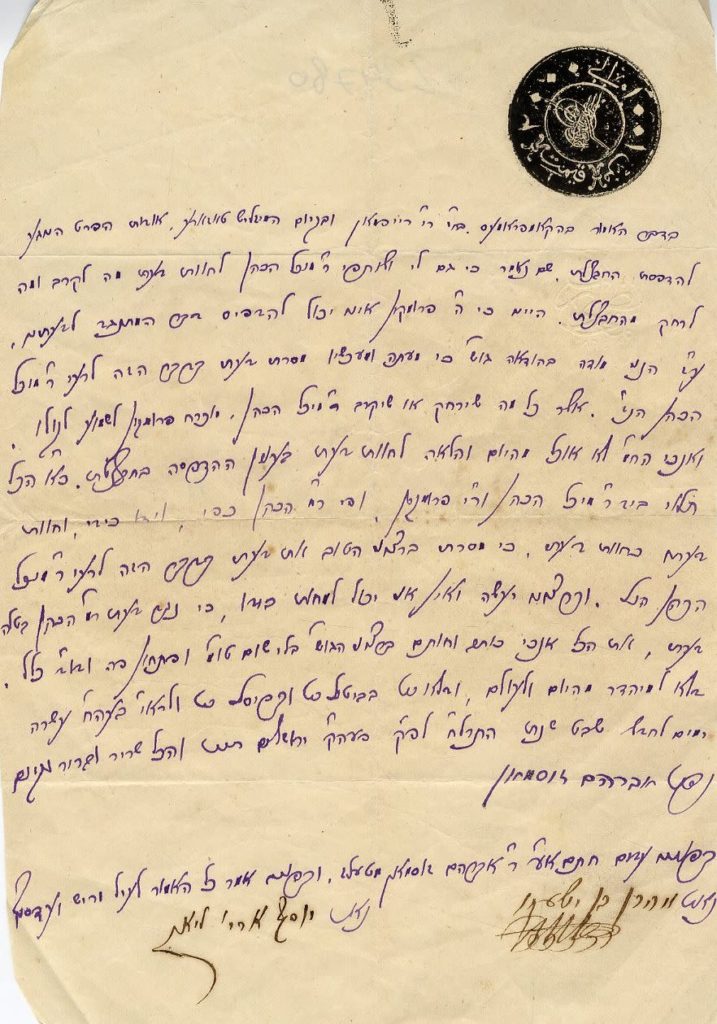
At the end of 1874, when R’ Michel HaKohen left Chavatzelet, he began to publish a monthly calledֲ HaArieli. At the top of the front page, he wrote: “Fifth Year,” because this editorship also included the years he was a partner in Chavatzelet. Subtitle: “Contains all that is necessary for the hearts of faithful lovers of Zion, by me, Michel HaKohen – Wish me well! Prepare my way.”
At the beginning of the second year, he increased the size of the picture of HaArieliֲ to be as in the format of most monthly periodicals, and he also brought Rabbi Avraham Zussman into the business. However, he only continued with this publication for two years, and ended it in 1876-7, with R’ Michel returning to the editorship of Chavatzelet. Rabbi Chaim Michel Michlen, the editor’s son-in-law, later wrote about him and about the newspaper: “He forgot one thing, and as a result did not see success. A newspaper cannot succeed in Jerusalem unless it has some material and moral support from a community or from a party … He was missing these three things: 1) No one supported him. 2) He did not have his own press at the time 3) He was desperately poor.”
This document attests to the events behind the veil of the administrators of the newspaper, when R’ Avraham Zussman gave over all his rights to R’ Michel HaKohen: “I, the undersigned, may not express my opinion, from this day forward, with respect to printing Chavatzelet; everything is dependent on R’ Michel HaKohen and R’ Y. Frumkin. R’ M. HaKohen’s word is as my word, his hand is as my hand, and his opinion is as my opinion. I have transferred my opinion in this matter from my own good will, to my friend, the above-mentioned R’ Michel HaKohen. He should do as he sees fit, and I may not protest.” Signing as witnesses: R’ Avraham ben Yeshayah and R’ Yosef Aryeh Lion. Stamp of HaShe’ari court at the top. Shevat 1878.
[1] leaf paper. 22×15 cm. Fine condition.
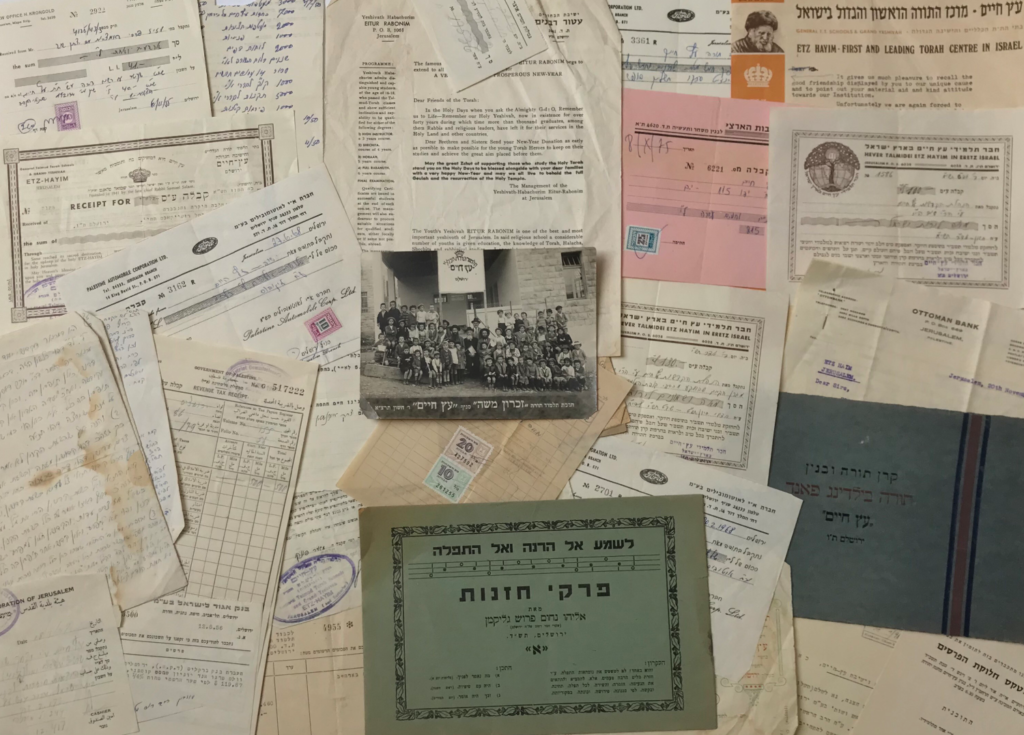
Treasure trove of hundreds of certificates and documents, some of which are extremely rare, from the Mandate era through 1975, related to the Etz Chaim Talmud Torah and yeshivah – the oldest yeshivah in the Land of Israel. The collection includes hundreds of items, with names of thousands of the yeshivah’s rabbis and students, donors from the Land of Israel and abroad, public institutions which were connected to the yeshivah, and much more. The collection constitutes an important, unique and authentic source of information for scholars of the Old Yishuv, and especially scholars of the period in general.
Highlights:
*ֲ Keren Torah U’Binyan, a booklet which was printed after the inauguration of the new building in the Machaneh Yehudah neighborhood. It includes original photographs of the event. With recommendations from the chief rabbis: Rabbi Avraham Yitzchak Kook and Rabbi Yosef Chaim Sonnenfeld.
* Rare booklet of melodies by Rabbi Eliyahu Nachum, son of Rabbi Shlomo Zalman Porush. R’ Eliyahu Nachum was among the leading activists of Jerusalem, and he served as spiritual dean of the Etz Chaim yeshivah together with R’ Aryeh Levin. He was musically gifted, and composed many melodies. This book is comprised of musical notes for the liturgical poems of Rosh HaShanah and Yom Kippur. Jerusalem, 1944.
* Monetary agreement between the yeshivah administration and the chief rabbi of Israel, Rabbi Yitzchak Isaac Herzog.
* Financial documents: bundle of dozens of authentic receipts; a bank statement; telegrams for foreign donors, prayers for their health, etc. Statements from Gema”ch Otzar HaChessed “Keren Shmuel”; a list of “kitchen workers”; the institution’s fundraising letters with signatures of principals and roshei yeshivah in Hebrew, English, and Russian[!].
* Educational documents: graduation diplomas for students; drafts of Talmud Torah regulations, including “Latecomers will be fined their bread ration until the next day”; a program for the “prize distribution ceremony” for outstanding students; a rare picture of an Etz Chaim branch in the Zichron Moshe neighborhood, students with their teachers; report of excellence in the classes, with the students’ names.
* Dozens of statements of payments made by the institution for various expenses, one receipt is signed by a yeshivah student, R’ Yehudah Shapira, who eventually became one of the greatest disciples of the Chazon Ish [rare!]. Among the expenses: Students guarding the dead [!] (one of the “guards” was R’ Yehudah [“Yudel”] Rabinowitz, who later became one of the leading rabbis of Jerusalem, loyal assistant of the gaon of Tchebin and one of the roshei yeshivah of Tchebin).
* Recommendation by chief rabbi of Israel Rabbi Yitzchak Nissim (English), for the yeshivah “Itur Rabbanim,” which is actually the junior branch of the Etz Chaim yeshivah.
* Typewritten lessons of the rosh yeshivah, the great gaon Rabbi Nota Freund, from 1975.
* Commitment of student A. G.: “To be a good student and to listen to all the lessons. To study well, to behave very well, and to carry out the rabbi shlit”a’s instructions. And if I don’t behave as written above, I have no place in the cheder. And I have no claims at all.”
* Included in the collection: A Matuneh fun Yerushalayim, a publication by the Jerusalem yeshivah, Torat Chaim, in which all of the rabbinical leaders of Jerusalem studied. There are 32 pages in the booklet, including the yeshivah’s history accompanied by rare photographs. The Torat Chaim yeshivah was founded in 1886 by Rabbi Yitzchak Winograd. In 1917, its financial situation worsened, and Rabbi Chaim Soloveitchik of Brisk took over responsibility for its support. He was very active in improving its situation. During the 1929 riots with the great Arab rebellion, the Jewish quarter emptied of its residents, and the yeshivah moved to the Achvah neighborhood in the new city. R’ Shimon Vinograd, R’ Yitzchak’s son, took over the yeshivah’s administration in 1931. R’ Shimon attempted to rejuvenate the yeshivah in the Geulah neighborhood; to this end he published this booklet. Jerusalem, 1933.
The collection is places in two binders. Fine condition.
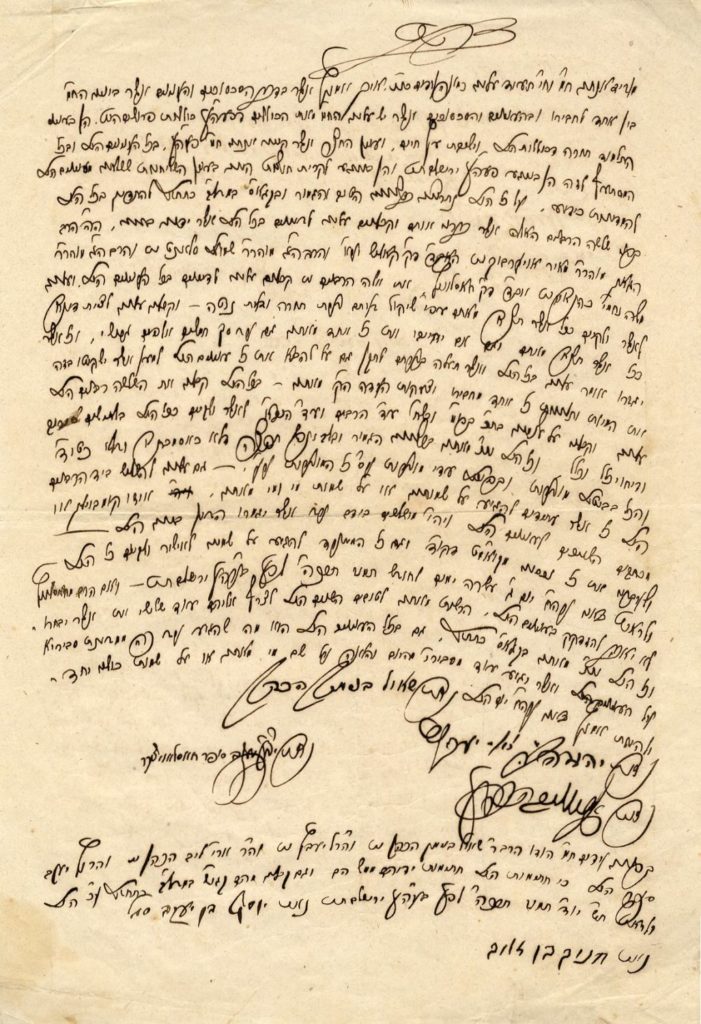
Arbitration agreement before Rabbi Shmuel Salant; Rabbi Meir Auerbach, Av Beit Din of Kalish, author of Imrei Binah; and Rabbi Moshe Nechemiah Kahanov. Regarding the affair of the terrible dispute which broke out in Jerusalem opposing the rabbi of Radishkowitz, Rabbi Shaul Binyamin HaKohen. Signed by litigants: Rabbi Shaul Binyamin HaKohen of Radishkowitz, Rabbi Yehudah Leib Ya’avetz, Rabbi Yitzchak Ya’akov Sofer Chaslawitzer and Rabbi Aryeh Leib HaKohen. Jerusalem, 1865.
We will briefly note the background to the dispute, as written by Rabbi Rephael Katzenelbogen, in his book Be’er Re’i – Toldot HaChinuch HaMekori B’Meshech HaDorot (Ch. 38): Rabbi Shmuel Binyamin HaKohen, rabbi in Radishkowitz, ascended to Jerusalem in 1857. When he arrived, he gathered a group of young men and began to study with them in Churvat R’ Yehudah HeChassid. He quickly became one of the administrators of the Churvah, and one of the managers of the Etz Chaim yeshivah. He had also been appointed an emissary and raised a lot of funds for the institutions. At the same time, he arranged the study at the Etz Chaim yeshivah, class division, etc. This had not been done until then, and was considered an “innovation” and change from the tradition. Rabbi Shaul Binyamin also registered the yeshivah’s property in his name, which aroused the suspicions of the veteran principals and became the trigger for the outbreak of the fierce controversy. The dispute was also conducted in the newspapers, and tradition relates that booklets were also published for and against, signed by the rabbinic leaders of Jerusalem. In the arbitration agreement before us, the sides accept upon themselves to be judged before the rabbis of Jerusalem: Rabbi Shmuel Salant, Rabbi Meir Auerbach, and Rabbi Moshe Nechemiah Kahanov, and to accept their ruling. This document sheds light on, and reveals many details about, one of the harshest disputes in Jerusalem, the dispute about the oldest Chareidi institution in Jerusalem, and apparently in all of the Land of Israel. (Refer to: Zichron L’Chovavim HaRishonim 13, ‘HaChatzer MiRadishkowitz.’) Background material is included.
[1] leaf paper. 29 cm. Fine condition. Aging stains. Fold marks.
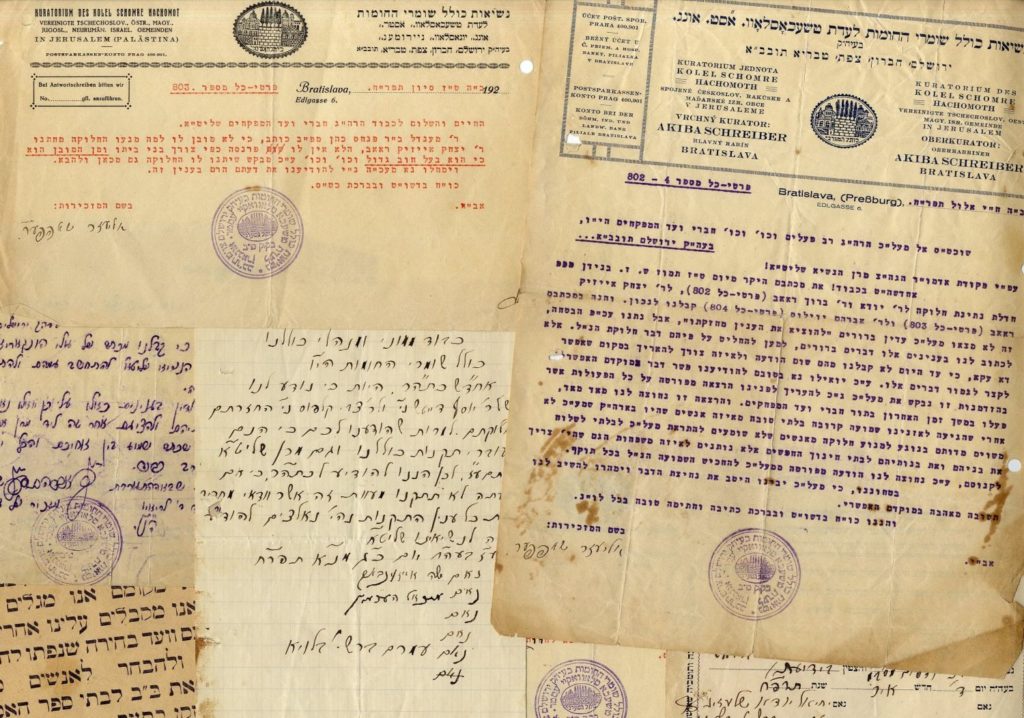
Archive from the establishment of the committee for the preservation of modesty and for the strengthening of education in Kollel Shomrei HaChomot’s educational institutions, and the Va’ad’s correspondence about those who transgressed. Fascinating.
A 1920 proclamation first publicized the establishment of “Va’ad Mishmeret HaDat V’HaTzniut,” a committee led by rabbis and activists. The content of the proclamation deals with the breach involving short clothing: “Exposed arms, shoulders and chests.” Therefore, they turn to girls and their parents to reverse this trend, and they will not let up on this goal until it is achieved. The poster lists the names of the rabbis responsible for the va’ad’s activities, and of the “nesi’im,” who are apparently those who carry out its activities. In a poster publicized in Sivan, 1936, in the streets of Jerusalem in the name of the “Va’ad HaRashi L’Mishmeret HaTzniut,” the decision to hold “a large public assembly is reported, “following the boundaries of modest clothing being increasingly breached;” so that they have decided, inter alia, to found ‘Mishmeret HaTzniut” whose object is to designate representatives in every neighborhood committed to examine each breach in the modesty of the women of the neighborhood. Indeed, several individuals organized themselves to carry out this initiative.
This group, led by Amram Blau, also served in a private capacity within Shomrei HaChomot, to impose the level of “Chareidi-ism” in the families. Members of the kollel turned to the president of the kollel – Rabbi Akiva Sofer, Av Beit Din of Pressburg, about their initiative to establish a committee to oversee the kollel families, to examine the level of modesty and Judaism within each family. Rabbi Sofer authorized this, and they immediately began to track the family members. When they found misconduct within a family, they immediately sent their names to the administrators of the kollel, who in turn stopped their stipends, and they were left without food or sustenance. These sanctions increased, aroused disputes and quarrels, and many turned with a cry for help to the rabbi of Pressburg, about their lives being endangered. The rabbi of Pressburg slowly began to retreat from this initiative, finally cancelling it completely in 1928. This turbulent affair is revealed here for the first time!
Refer to Winner’s Hebrew website text for a detailed list of the documents in this lot.
Various sizes and conditions. Overall fine condition.
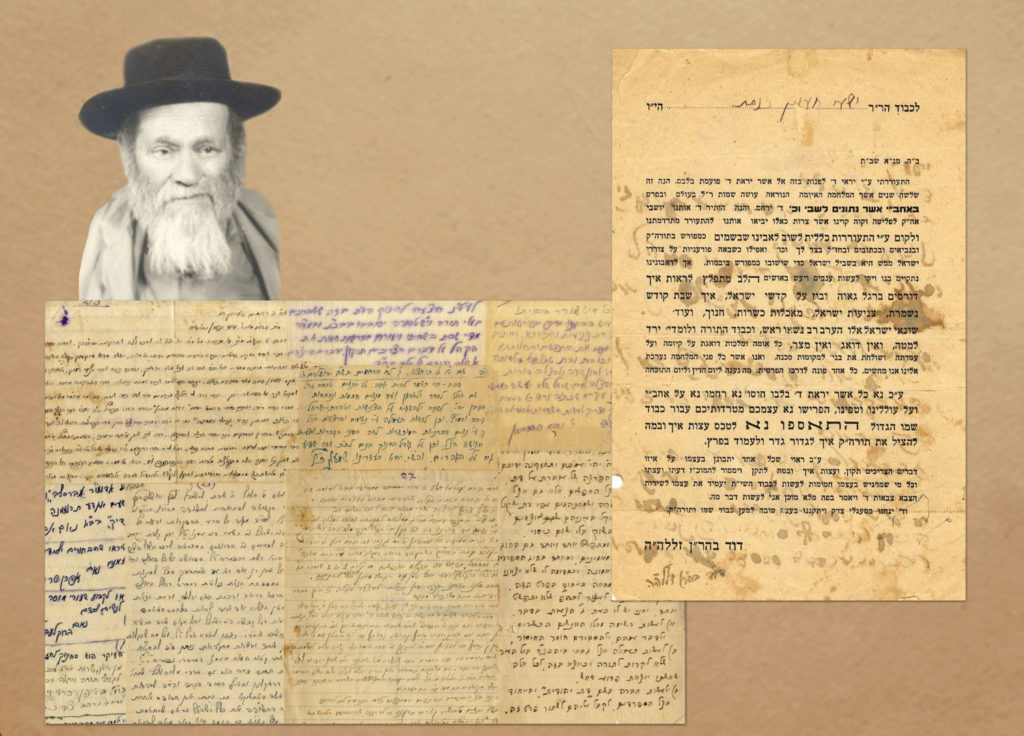
From 1940 onward there was a public dispute in Jerusalem regarding the character of the city. The dispute took place across several strata: the attitude towards the Va’ad HaLeumi, changes in the educational presses, changes in language from Yiddish to Hebrew, and changes in the dress of both men and women.
Rabbi David was fearful of all changes, and stood against any deviation from old practices. This folder reveals an as-yet unknown facet of this. In 1942, he turned to many of the people in the yishuv with two initiatives. One was the necessity of establishing a “chaburah” in which young and old gather together to strengthen Divine service and stand as a wall against breaches. The second initiative was a list of recommendations as to how to enlist “soldiers” to guard this watch.
Before us are approximately 20 responses written by noted Chareidi citizens of the city, who responded to his initiative, each with his own ideas and recommendations.
For example: Rabbi Shmuel Tefilansky, Rabbi Baruch Yitzchak Freund, R’ Nachum Friedman, R’ Shneur Friedman, R’ Shraga Feivel Frank, R’ Alter Heller, R’ Hillel Wind, R’ Baruch Loebel, R’ Avraham Hersch Cohen and others. These activities of his for the sake of strengthening religion are completely unknown; they are revealed here for the first time!
Printed poster from Rabbi David Bahara”n: ‘Letter of reproach from a Yerushalmi Jew from the old generation to the editor of theֲ Kol Yisraelֲ newspaper.’
In Adar 1936, a private letter from R’ Elchanan to his acquaintance, R’ David Potash, then of Tel Aviv, was published. The content of the letter was an extremely sharp protest against Agudat Yisrael’s considering politically joining the Va’ad HaLeumi; and that he has no doubt that in the lifetime of Rabbi Yosef Chaim Sonnenfeld, they would not have been content with this. Various activists distributed the letter in the streets of Jerusalem, under the title ‘Halachah Pesukah m’et Geon Yisrael’ about the negotiations between Agudat Yisrael and the Va’ad HaLeumi. As a result of this publication, a letter to the editorֲ appeared inֲ Kol Yisraelֲ [20 Iyar 1935]ֲ from one of the prominent citizens of the city, attesting that he had the impression that R’ Elchanan did not at all intend the negotiation being carried out those days at the initiative of Agudat Yisrael, about the legal status of the communities. After he raised several more unusual aspects of the letter’s contents, he concludes that they are only to rely on the words of Rabbi Dushinsky, who is the rabbi of the city.
As a response to this, R’ David Bahara”n published an objection to the writer of the above letter. 27 Iyar, 1935. Extremely rare.
Rabbi David was born in 1866 to his father, the gaon R’ Nachum of Shadik, and to his mother, Minnah-Leah, daughter of the famous gaon Rabbi Moshe Maggid (Rivlin), leader of the Perushim community. He was orphaned the same year he was born, and was raised and educated by his half-brother R’ Shlomo Zalman Bahara”n – one of the leading activists in the city, and was also educated by Rabbi Meir Auerbach – rabbi of the city. He married Sarah, daughter of the gaon Rabbi Akiva Yosef Schlesinger, when he was 16 years old. After his marriage, he studied at the Etz Chaim yeshivah, and when Rabbi Yehoshua Leib Diskin ascended to Jerusalem, he was drawn to him and studied under him. He was one of the founders of the Ohel Moshe yeshivah, and studied there until his passing. He was one of the leading Torah scholars of the city; he trembled over each every halachah, and was one of the leaders of Shomrei Mishmeret HaKodesh. He passed away on 27 Av 1946.
Various conditions and sizes. Overall fine condition.
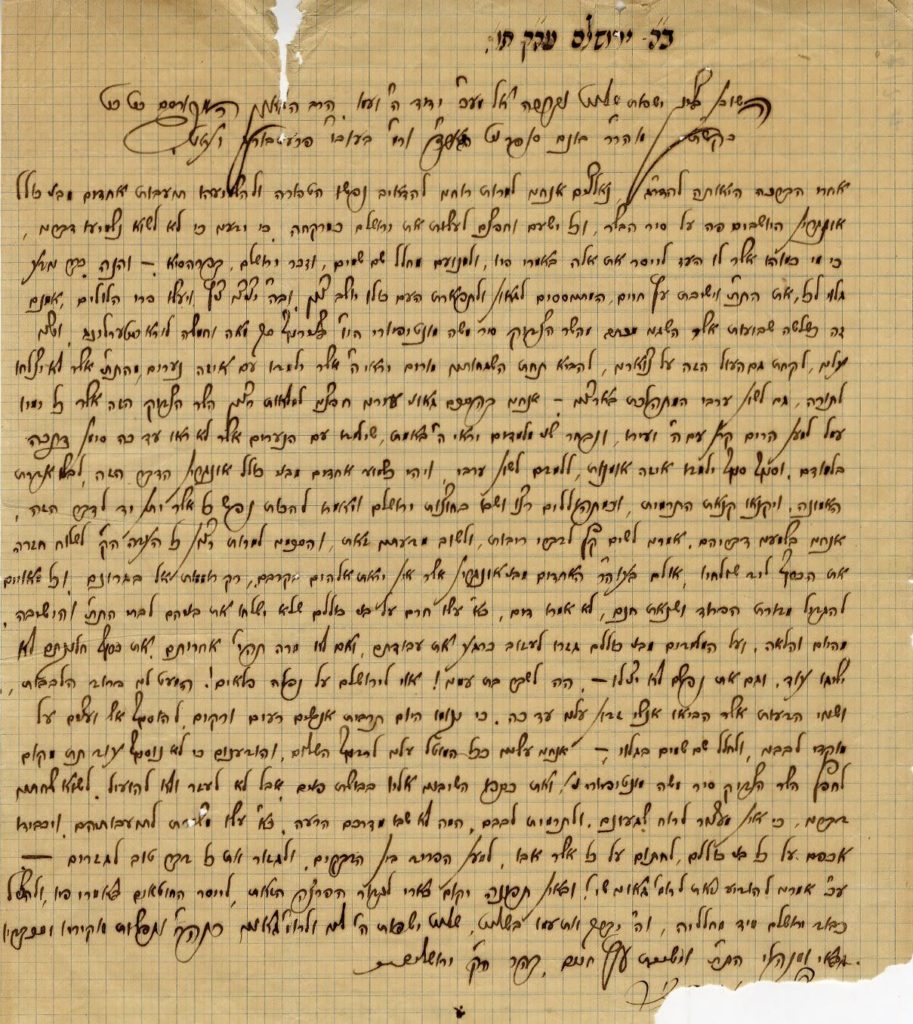
Polemic letter from the rabbis of the ‘Etz Chaim’ yeshivah, – the oldest institution in Jerusalem, to the gaon Rabbi Simchah Bunum Sofer, author ofֲ Da’at Sofer, of Pressburg, discussing studying secular subjects and Arabic language study per the Montefiore Plan. Jerusalem, 19th century. Historic document. Letter sent to the head of the Hungarian exile, the author ofֲ Da’at Sofer of Pressburg, with a sharp complaint against the members of Kollel Ungarin who reside in Jerusalem, who are harassing the Etz Chaim yeshivah since they began the ‘Montefiore Plan’ and introduced secular study into the Talmud Torah. In their letter, the rashei yeshivah describe the progression of the matter in great detail, and the reason which prompted them to accept the Plan: “… some youths from the Talmud Torah who were not successful in their Torah studies … and the Arabic language is making its way in our Land … We, with the agreement of the geonim of our city, desired to fulfill the will of the righteous Sir Moshe Montefiore.” Yet they almost immediately retract from the Plan and commit to distancing themselves from it. Between the lines, we can sense the great bitterness, that is not to say the jealousy of the residents of Jerusalem of the Kollel Ungarin members, a kollel which distributed a regular monthly stipend to each of its members, albeit scant, but those years hunger was rampant, and that stipend made the difference between life and death by starvation, literally. This was also a sanction taken by the heads of Kollel Ungarin against the Etz Chaim yeshivah, because if a kollel member sent his children to study at the yeshivah, his stipend would immediately cease. It is no wonder that this sanction quickly caused Etz Chaim to retract from participating in the Montefiore Plan. [1] leaf graph paper. 26 cm. Scribal script with remnants of the signature of the rosh yeshivah, the gaon Rabbi Moshe Nechemiah Kahanov. Moderate condition. Tears. Large tear in the lower right corner, erasing the names of the signatories on the letter.
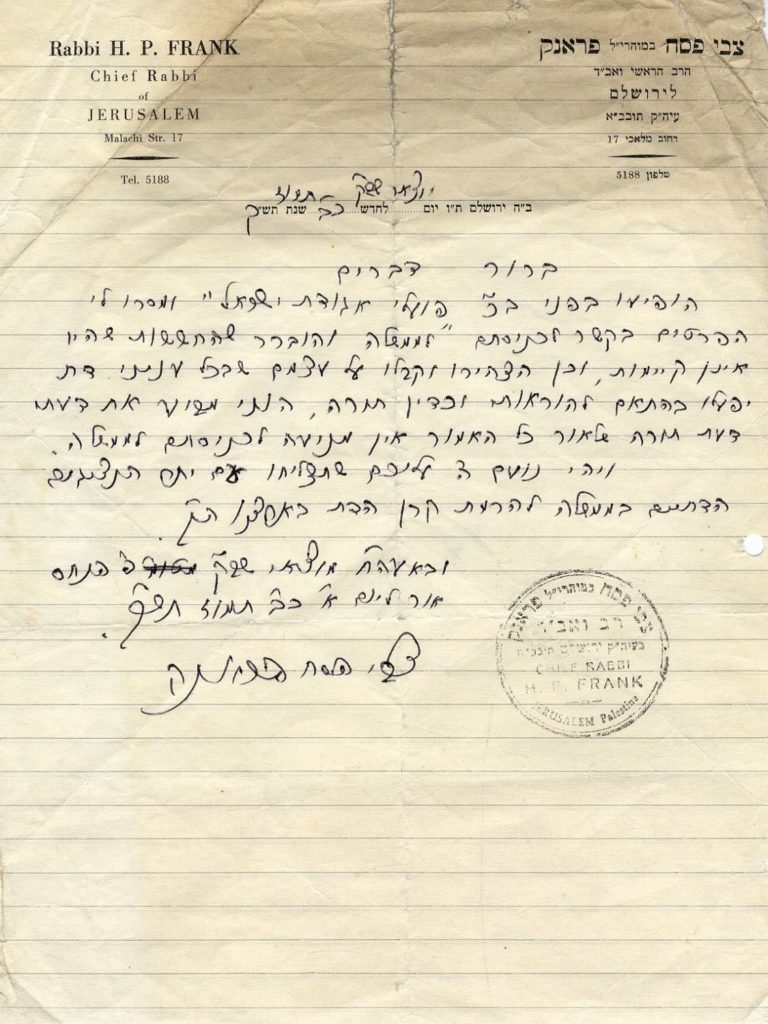
“I hereby express my Torah opinion that considering all that was stated, there is no impediment to their entering the government.”
Document of historic importance permitting the Poalei Agudat Yisrael movement to enter the government, against the decision of the Agudat Yisrael party and the Council of Torah Sages.
Under the headline, “Clarification of the Matter,” the chief rabbi of Jerusalem, Rabbi Tzvi Pesach Frank, wrote that people from Poalei Agudat Yisrael appeared before him and gave him details about their plan to join the government. “And they accepted upon themselves that in all matters of religion, they will act according to instruction and Torah Law.”
On July 17, 1960, three members of Poalei Agudat Yisrael joined the coalition. As a result of this, on August 9, the United Torah Front party split into its two constituent parts – Poalei Agudat Yisrael and Agudat Yisrael. This caused a crisis among religious Jewry and a representative of Poalei Agudat Yisrael was even personally excommunicated as one who flouted the instructions of the Council of Torah Sages. At the height of the struggle against him, he was humiliated in various ways, which brought about, according to what is told, negotiating joining together with the National Religious party, which ended with his sudden death.
[1] leaf official stationery as chief rabbi of Jerusalem. Signed and stamped by him. 20×27 cm.
* Letter encouraging joining the Poalei Agudat Yisrael initiative to arouse strengthening religion, Torah study, dissemination of Torah, and strengthening original Torah education.
The letter is signed by Rabbi Tzvi Pesach Frank and Rabbi Baruch Marcus (rabbi of Haifa). It is dated 4 Av, 1960 and was written in the midst of the days of turbulent struggle and division, and is certainly connected to the dispute.
* ‘Teshuvah L’Rabbim’ – letter from Rabbi Shraga Feivel Frank, nephew of Rabbi Tzvi Pesach Frank, confirming his uncle’s aforementioned letter.
Rabbi Tzvi Pesach Frank passed away in Kislev, 1960, just a few months after the rift between Agudat Yisrael and Poalei Agudat Yisrael, and just a few months after the aforementioned letter. In the meantime, there were questions and doubts raised about the veracity of the letter. Therefore, his nephew wrote that he attests that this is the handwriting of his uncle, Rabbi Tzvi Pesach Frank, adding “written in my presence and signed in my presence.”
Rabbi Chaim Shraga Feivel Frank (1908-1973) was rabbi of the Yemin Moshe neighborhood of Jerusalem.
* Especially lengthy letter written by Rabbi Ya’akov Yisrael Kanievsky [the Steipler] requesting and pleading that he retract the proclamation published in his name to remove members of Poalei Agudat Yisrael from society.
It is known that Rabbi Ya’akov Yisrael Kanievsky was among the leaders of the opposition to Poalei Agudat Yisrael, and until his last day he refused to cooperate with them. This letter is written very submissively, faced with the question as to whether he was given all the relevant details. The letter contains interesting details about this difficult affair.
A total of 4 important documents. Overall fine condition.
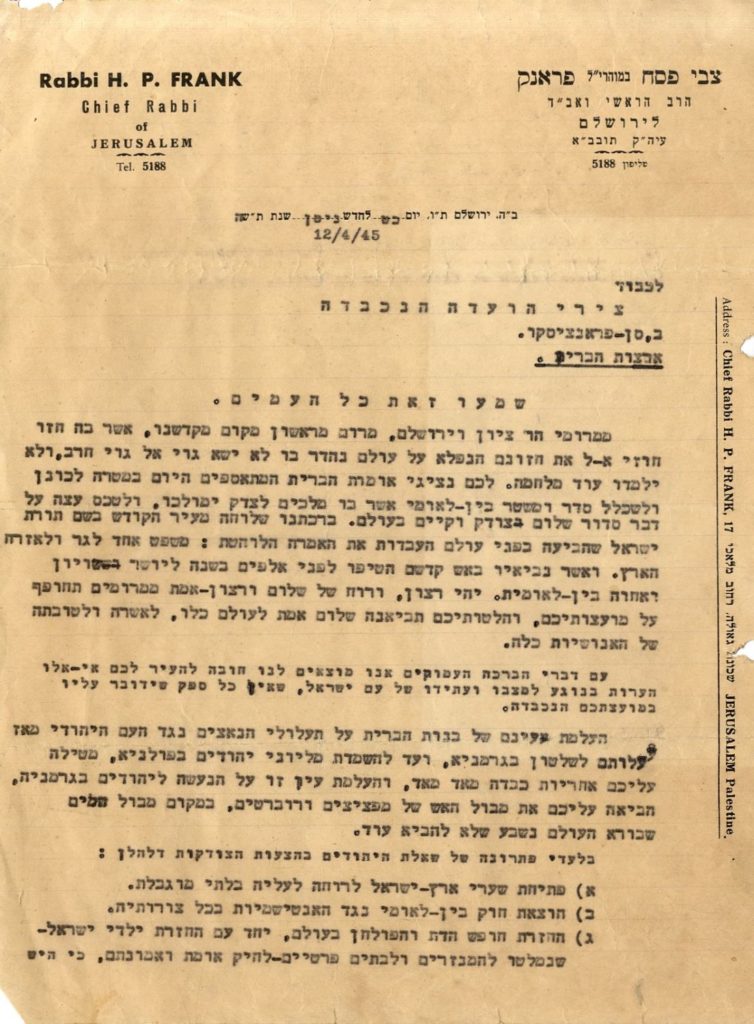
Rabbi Tzvi Pesach Frank’s historic letter to the representatives of 50 of the world’s nations who assembled in San Francisco for the United Nations Conference on International Organization, whose goal was to establish the UN. The United Nations Charter was drafted and written over the course of this conference. Jerusalem, April/Nissan 1945. This letter was ingeniously worded by the elder rabbi of Jerusalem in polite diplomatic language, rooted in Jewish gentleness. But at the same time, he flings the guilt of the nations of the world at their representatives, and their part in the destruction of most of the Jewish people, and their moral obligation to assist “the moaning, persecuted most ancient people.” He writes as a prophet at the city gates: “Listen to this, all nations, from the heights of Mount Zion and Jerusalem … the Allies’ turning a blind eye to the Nazi atrocities against the Jewish people from the time of the Nazi rise to power to Germany until the destruction of millions of Jews in Poland, places a very, very heavy responsibility on you … and this turning a blind eye brought upon you the flood of the fire of bombs and rockets in place of the flood of water that the Creator of the world swore he would not bring again.” He continues: “Cast your eyes, honored representatives, to Auschwitz, Treblinka and Belzec, and listen to the voices silenced by all types of incomprehensible deaths that only the hand of Satan could fabricate …” The letter before us was part of the the diplomatic struggle between the Jewish people and the Arab delegations, with respect to Section 80 of Chapter 12 in the UN Charter, which was drafted and written, as mentioned above, during the course of the San Francisco Conference. This Section 80 deals with defending the rights of the Jewish nation and the national home, which is included in Britain’s mandate in the Land of Israel. In his letter, Rabbi Tzvi Pesach Frank raises three demands: 1) wide opening of the gates of the Land of Israel to unlimited immigration 2) enactment of an international law against antisemitism 3) declaring freedom of religion and freedom of worship, and return of all the Jewish children who escaped to monasteries. The United Nations Charter – the organization’s constitutive document, which was sealed two weeks after Rabbi Frank’s letter, held much importance, also in that Israel’s Declaration of Independence states: “The State of Israel … will be faithful to the principles of the UN Charter.” [2] leaves of official stationery. 21×27 cm. Typewritten; signed and stamped by the chief rabbi; fine condition. Filing perforation. Fold marks. Tiny tears in the folds and in the white margins, without damage to text.
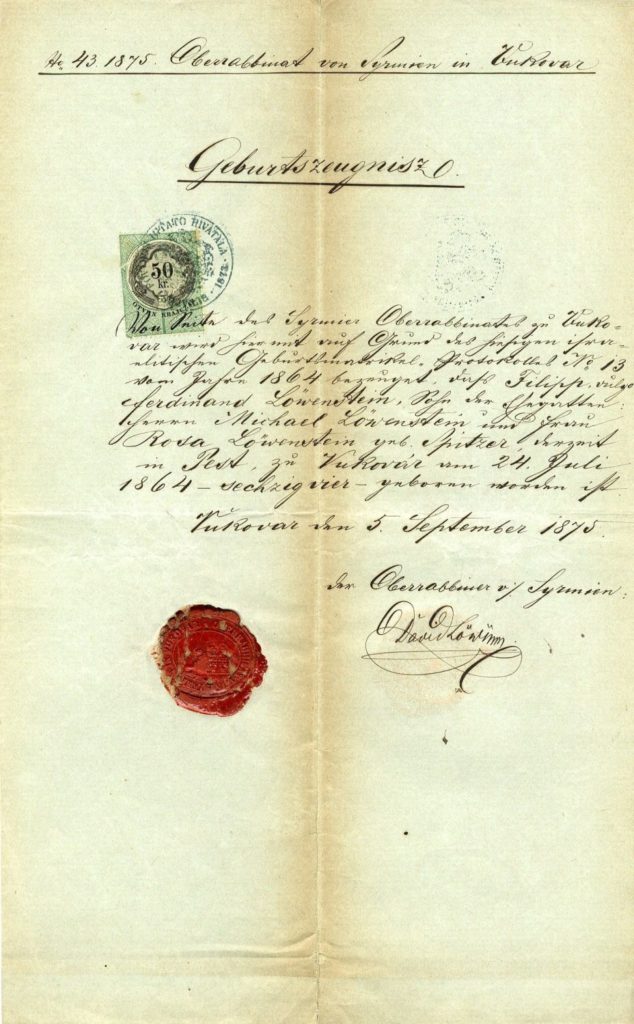
48 documents and letters from various Hungarian communities; some are from communities in nearby countries. Including official documents, birth and death certificates, various contracts, depositions, and letters. Most of the documents are in Hungarian, some are in German. 1830-1944.
The documents and letters are handwritten and signed by the rabbis, some are written on official stationery blanks, and many of them are sealed with a wax seal.
Refer to the Hebrew text for a complete list of the rabbinic signatories.
Varied and interesting collection, important for the study of the history of Hungarian Jewry. Overall fine condition.
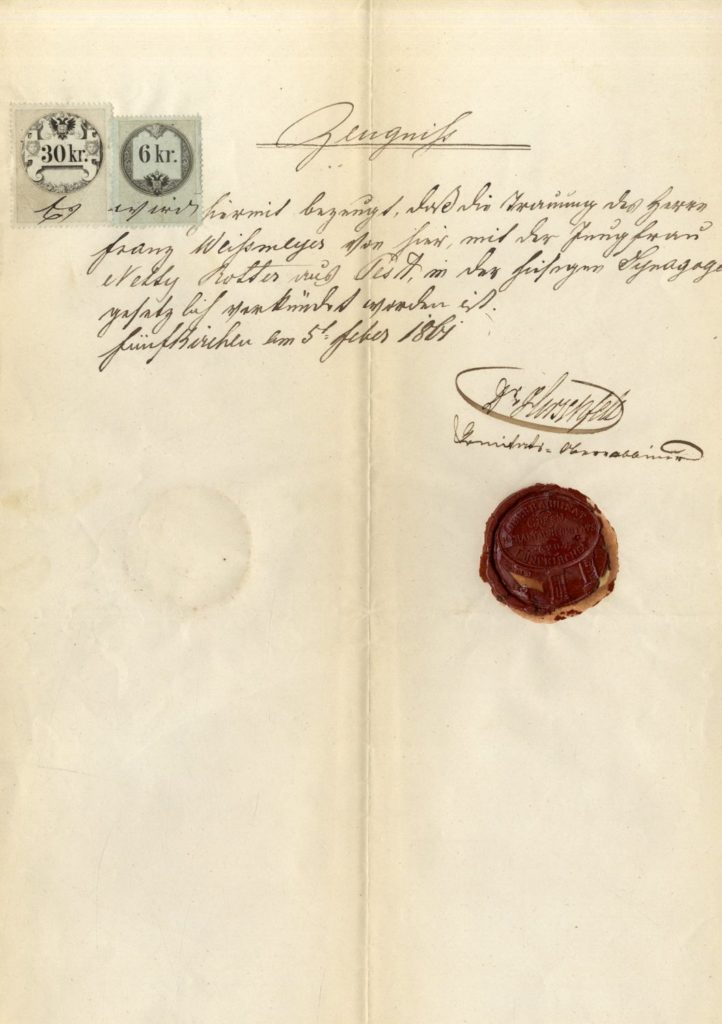
48 documents from various Hungarian communities. Including official documents, birth and death certificates, various contracts, depositions and letters. Most of the documents are in Hungarian; some are in German.
The letters and documents are handwritten and signed by the rabbis. Some are written on stationery blanks, and a large number of them are also stamped with a wax stamp.
For a complete list of the rabbinic signatories, refer to Winner’s Hebrew site.
Multifaceted and interesting collection. Important for the study of the history of Hungarian Jewry. Overall fine condition.
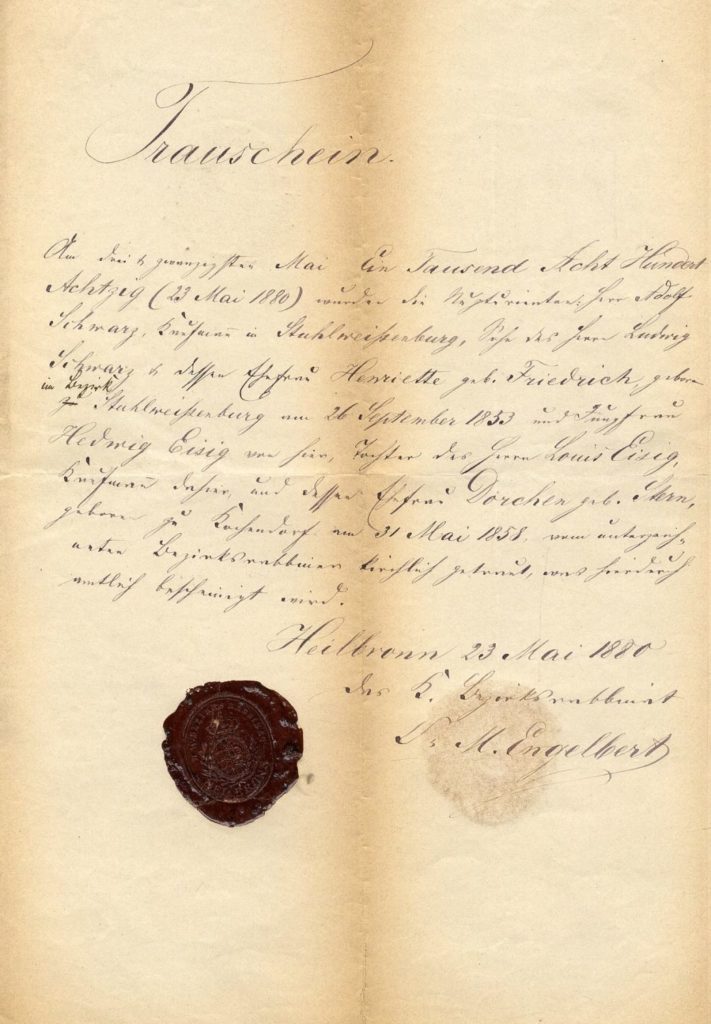
48 documents and letters from various Hungarian communities, including official documents, birth and death certificates, depositions, and letters. Most of the documents are in Hungarian; some are in German.
The documents and letters are handwritten and signed by the rabbis, some are written on official stationery blanks, and many of them are sealed with a wax seal.
Refer to the Hebrew text for a complete list of the rabbinic signatories.
Varied and interesting collection, important for the study of the history of Hungarian Jewry. Overall fine condition.
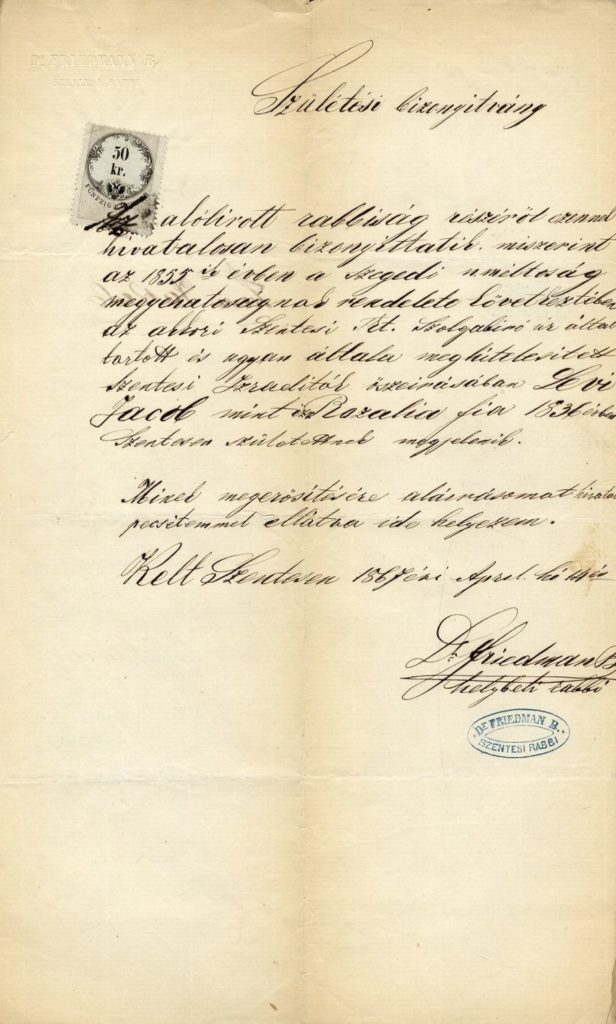
48 documents and letters from various Hungarian communities, including official documents, birth and death certificates, various contracts, depositions, and letters. Most of the documents are in Hungarian; some are in German.
The documents and letters are handwritten and signed by the rabbis, some are written on official stationery blanks, and many of them are also sealed with a wax seal.
Refer to the Hebrew text for a complete list of the rabbinic signatories.
Varied and interesting collection, important for the study of the history of Hungarian Jewry. Overall fine condition.
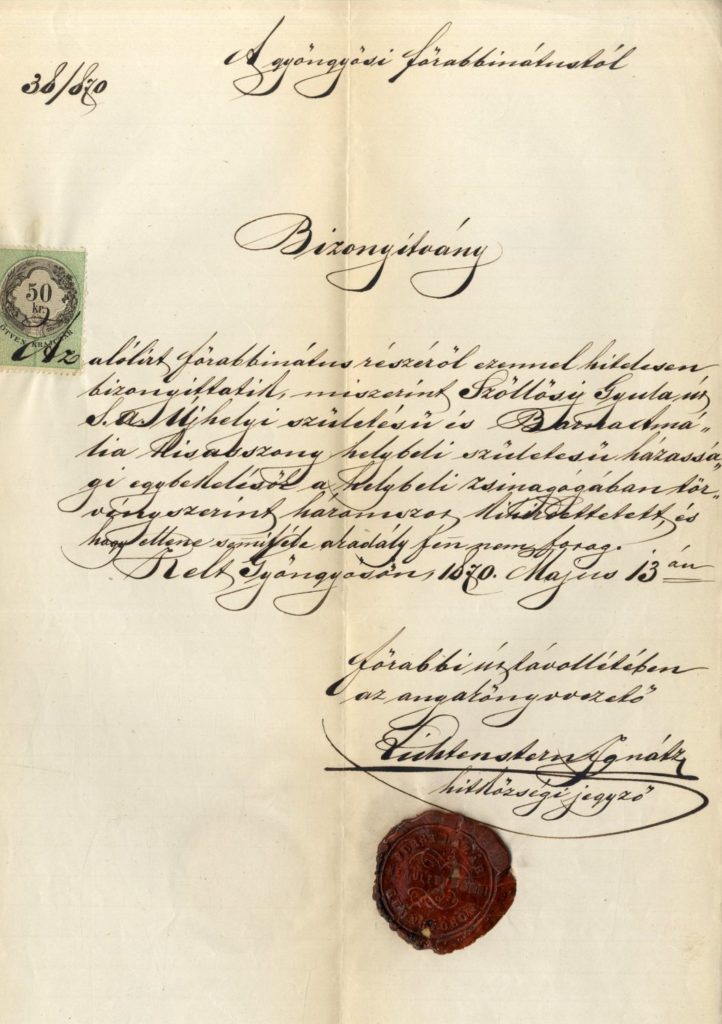
48 documents from various Hungarian communities. Including official documents, birth and death certificates, various contracts, depositions and letters. Most of the documents are in Hungarian; some are in German.
The letters and documents are handwritten and signed by the rabbis. Some are written on stationery blanks, and a large number of them are also stamped with a wax stamp.
For a complete list of the rabbinic signatories, refer to Winner’s Hebrew site.
Multifaceted and interesting collection. Important for the study of the history of Hungarian Jewry. Overall fine condition.
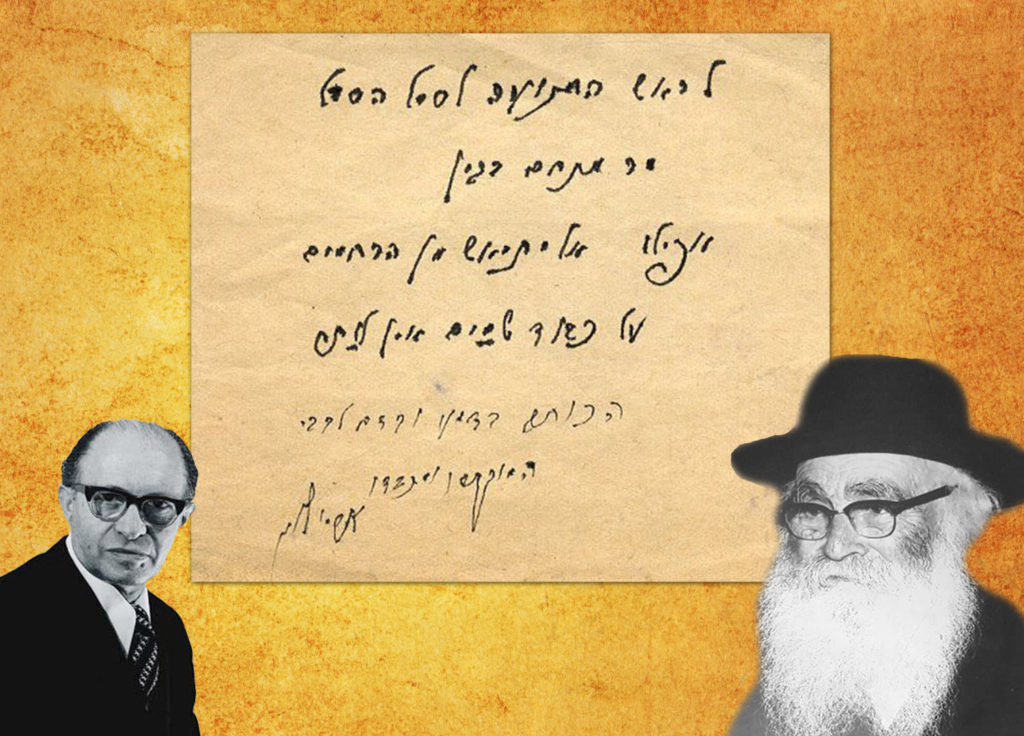
Interesting historic note by the tzaddik of Jerusalem, Rabbi Aryeh Levin, to Mr. Menachem Begin, later prime minister of Israel: “To the leader of the movement, the symbol of hardship, even do not despair of mercy, do not forgo on Heav-nly honor. Writing with tears and lifeblood, with appreciation and honor, Aryeh Levin.”
The note is not dated, and the circumstances under which is was written are unknown. It was written using inferences, and apparently the matter at stake was weighty. Rabbi Aryeh hints at this with the words: “Even do not despair of mercy.” He leaves a space after “Even” to hint at the Talmudic phrase (Tractate Berachot 10a), “Even when a sharp sword is held at a person’s throat.”
The tzaddik Rabbi Aryeh Levin [1885-1965] was one of the glorious personages of Jerusalem, a great gaon in all aspects of Torah and a merciful father to all the oppressed. He was known as the rabbi of the underground prisoners during period of the British Mandate because he would walk to the prison every Shabbat to visit them and raise their spirits. During his visits to the underground prisoners, Rabbi Aryeh would smuggle notes to and from the prisoners and their families. He was especially connected to Olei HaGardom, and visited them before they were executed.
[1] leaf paper. 10×9 cm. Entirely handwritten and signed by Rabbi Aryeh Levin.
Fine condition. Tears in the white margins without damage to text.